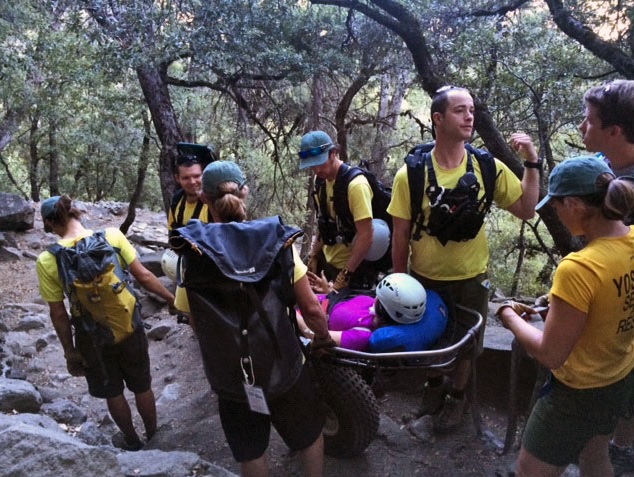YOSEMITE – The men and women at Yosemite Search and Rescue (YOSAR) ask that visitors to Yosemite National Park take extra care to avoid becoming someone who needs to be rescued.
On Tuesday, Sept. 2, the Yosemite Emergency Communications Center received a cell phone call from a hiker on the Yosemite Falls Trail requesting help for a member of the hiker’s group.
According to the hiker, a 28-year-old woman had slipped and fallen onto a rock. The subject had broken several teeth and was bleeding profusely. The hiker stated that the group was at Columbia Rock, which is approximately one mile up the Yosemite Falls Trail.
A ranger-paramedic started up the trail and located the subject approximately fifteen minutes up the trail. The woman had severely injured her mouth, and three other adults were with her.
According to the hiker who reported the accident, while the group was at Columbia Rock, they decided to take a jumping photo to post on social media. The group of hikers, including the subject, had all jumped and tucked their legs behind them. When the woman landed, she slipped forward on gravel and face-planted on a rock. The group of hikers was able to start hiking down trail until they met up with the ranger-paramedic.
The ranger-paramedic administered pain medication to the subject. Typically, the medication makes people dizzy, so the ranger requested a litter team to carry out the subject. A litter team was assembled and reached the subject within thirty minutes of the request.
Yosemite Search and Rescue (YOSAR) can extract an ill or injured party out of the backcountry on crutches, by horseback, or even by helicopter, but in most cases, YOSAR utilizes a litter carry-out team. For this incident, a litter carry-out was the best option.
A litter team is comprised of at least six people (ideally more), a metal litter (the basket the subject lies in) and an ATV wheel that attaches to the bottom of the litter. The subject is strapped into the litter, the wheel is screwed onto the bottom, and then three people hold each side of the litter and guide the wheeled litter along the trail. Additional rescuers can act as a brake for the litter, or as horsepower, pulling from either end of the litter depending on the slope of the terrain.
Because the subject was only fifteen minutes up the trail, six YOSAR personnel, in addition to the ranger-paramedic already on scene, could safely extract the subject. If the carry-out had been longer, if the terrain had been more strenuous, or if the subject had been heavier, the litter team would have included more rescuers.
While there is no exact formula for the number of rescuers to send on a litter carry out, more is usually better. Often, rescuers will have to maneuver difficult terrain in precarious areas, navigate in the dark or poor weather conditions, all the while attempting to get the subject to definitive care as quickly as possible. On the other hand, the incident command team is always mindful that in Yosemite it is not uncommon for multiple rescues to take place at the same time, and to adjust accordingly the number of rescuers committed to each mission.
While the subject in this particular rescue fell while jumping, she could have just as easily suffered the same injury on the same trail while walking. Sloped, gravel-covered surfaces comprise the majority of the Yosemite Falls Trail, and ground-level falls are common. Be aware that even the most experienced hiker can turn an ankle or slip on any trail, and take care to stack the odds in your favor. While good preparation won’t guarantee you will complete your hike safely, it will greatly increase your chances of arriving at the trail head injury free.
• Wear sturdy footwear with good traction.
• Drink plenty of water and eat snacks regularly.
• Know your fitness level and pay attention to how you are feeling during your hike.
• Tell someone responsible where you are going and when you expect to return.
YOSAR story originally published by the National Park Service as part of Search and Rescue: Lessons from the Field Homepage




